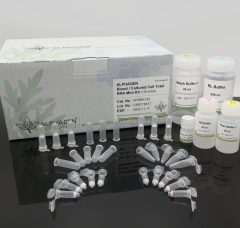TransStbl3 ( Stbl3 ) Competent Cell – CD521

$202.00 – $330.00 CAD
Out of stock
Stbl3 Competent Cells
TransStbl3 Chemically Competent Cells (Stbl3) are specifically designed for chemical transformation of DNA containing long terminal repeats (LTR) found in lentiviral vectors. Unlike other E. coli cloning competent cells such as DH5α, TOP10, these cells reduce the frequency of homologous recombination of long terminal repeats (LTRs). Transformation efficiency is over 108 cfu/μg DNA (tested by pUC19 plasmid DNA) and plasmid DNA yield is higher than other E.Coli strains.
Characteristics of Stbl3 Competent Cells
- High transformation efficiency: >108 cfu/μg (pUC19 DNA).
- High plasmid DNA yield
- Suitable for transformation of lentivirus and retrovirus plasmid vectors containg (LTRs)and unstable DNA sequences.
- Streptomycin resistant.
- Reduced frequency of homologous recombination of long terminal repeats (LTR).
- Not suitable for blue/white colony screening.
- Compatible with Seamless DNA Assembly mixes such as pEASY-Uni CU101
Genotype of Stbl3 Cells
F- mcrB mrr hsdS20(rB-, mB-) recA13 supE44 ara-14 galK2 lacY1 proA2 rpsL20 (StrR) xyl-5 λ-leu mtl-1
Visit our complete Cloning Competent Cell comparison and selection chart
Compare !Product Manual and Datasheet
CD521 TransStbl3 Chemically Competent Cell
Genotype definitions (if applicable to this product)
| Genotype | Description |
|---|---|
| ara-14 | Blocks arabinose catabolism |
| argF | Ornithine carbamoyltransferase mutation blocks ability to use arginine |
| dam/dcm | Abolishes endogenous adenine methylation at GATC sequences (dam) or cytosine methylation at CCWGG sequences (dcm). Used to propagate DNA for cleavage with certain restriction enzymes (e.g. Ava II, Bcl I) |
| DE3 | Lysogen that encodes T7 RNA polymerase. Used to induce expression in T7-driven expression systems |
| endA | endA Mutation in the non-specific endonuclease Endonuclease I; eliminates non-specific endonuclease activity, resulting in improved plasmid preps |
| F´ | A self-transmissible, low-copy plasmid used for the generation of single-stranded DNA when infected with M13 phage; may contain a resistance marker to allow maintenance and will often carry the lacI and lacZ∆M15 genotypes |
| galK | Galactokinase mutation blocks catabolism of galactose—cells that are galK minus grow in the presence of galactose as the sole carbon source |
| galU | Glucose-1-phosphate uridylyltransferase mutation blocks ability to use galactose—cells that are galU minus can grow on media that contains galactose as the sole carbon source |
| gyrA96 | DNA gyrase mutant produces resistance to nalidixic acid |
| hsd | Mutations in the system of methylation and restriction that allow E. coli to recognize DNA as foreign. The hsd genotype allows efficient transformation of DNA generated from PCR reactions *hsdR–eliminates restriction of unmethylated EcoK I sites. (1) **hs |
| lacI | Encodes the lac repressor that controls expression from promoters that carry the lac operator; IPTG binds the lac repressor and derepresses the promoter; often used when performing blue/white screening or to control expression of recombinant genes |
| lacY1 | Blocks use of lactose via β-D-galactosidase mutant |
| lacZ | β-D-galactosidase gene; mutations yield colorless (vs. blue) colonies in the presence of X-gal |
| lacZ∆M15 | Element required for β-galactosidase complementation when plated on X-gal; used in blue/white screening of recombinants; usually carried on the lambdoid prophage φ80 or F´ |
| leuB | Requires leucine for growth on minimal media via β-isopropyl malate dehydrogenase mutation |
| lon | lon Deficiency in the Lon ATPase-dependent protease; decreases the degradation of recombinant proteins; all B strains carry this mutation |
| mcrA, mcrBC,or mrr | Mutations that allow methylated DNA to not be recognized as foreign; this genotype is necessary when cloning genomic DNA or methylated cDNA |
| nupG | Mutation for the transport of nucleosides |
| ompT | Indicates that the E. coli lack an outer membrane protease—reduces degradation of heterologous the strains and recovery of intact recombinant proteins is improved in ompT minus strains |
| P3 | A 60-kb low-copy plasmid that carries the ampicillin and tetracycline resistance genes with amber mutations; used predominantly for selection of supF-containing plasmids; carries the kanamycin resistance gene for selection |
| pLys | pLys Plasmid that encodes T7 lysozyme; used to reduce basal expression in T7-driven expression systems by inhibiting basal levels of T7 RNA polymerase |
| proAB | proAB Requires proline for growth on minimal media |
| recA | Mutation in a gene responsible for general recombination of DNA; particularly desirable when cloning genes with direct repeats |
| relA | RNA is synthesized in absence of protein synthesis (relaxed phenotype) relA locus regulates the coupling between transcription and translation. In the wild type, limiting amino acid concentrations results in the shutdown of RNA synthesis (also known as th |
| rpsL | Confers resistance to streptomycin (this makes a mutant ribosomal protein, small subunit, the target of the drug) |
| supE,F | tRNA glutamine suppressor of amber (supE)(UAG) or tyrosine (supF) |
| thi-1 | Requires thiamine for growth on minimal media |
| Tn10 | Confers tetracycline resistance via a transposon |
| tonA | Confers resistance to the lytic bacteriophage T1, T5 and f80 |
| traD, D36 | Prevents transfer of F’ episome via transfer factor mutation |
| tsx | Confers resistance to phage T6 and colicin K |
| xyl-5 | Blocks catabolism of xylose |
Additional information
| Format | 10 x 100 ul, 20 x 100 ul |
|---|---|
| Supplier |


Reviews